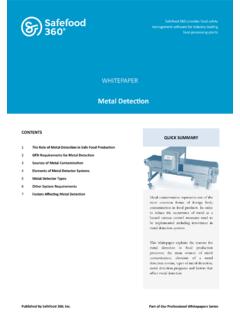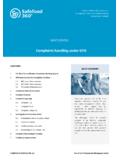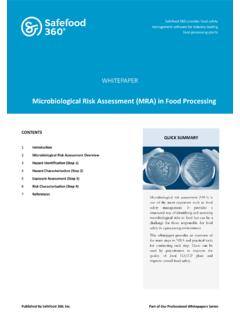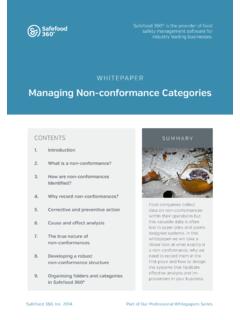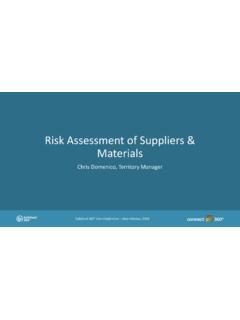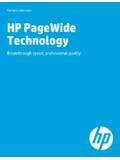Transcription of Metal Detection - Safefood 360°
1 Safefood 360 provides food safety management software for industry leading food processing plants whitepaper QUICK SUMMARY Published by Safefood 360, Inc. Part of Our Professional Whitepapers Series Metal contamination represents one of the most common forms of foreign body contamination in food products. In order to reduce the occurrence of Metal as a hazard various control measures need to be implemented including investment in Metal Detection systems. This whitepaper explains the reasons for Metal Detection in food production processes, the main sources of Metal contamination , elements of a Metal Detection system, types of Metal Detection , Metal Detection programs and factors that affect Metal Detection . CONTENTS 1 The Role of Metal Detection in Safe Food Production 2 GFSI Requirements for Metal Detection 3 Sources of Metal contamination 4 Elements of Metal Detector Systems 5 Metal Detector Types 6 Other System Requirements 7 Factors Affecting Metal Detection Metal Detection Metal Detection 2 Safefood 360 whitepaper (April, 2013) Metal contamination of food products is a fact of food manufacturing life.
2 Even with the most robust Metal Detection controls, Metal contamination of food still occurs. As is the case with many aspects of food safety our objective is the reduction of Metal hazards to an acceptable level where total elimination is not possible. If we take a look at modern food manufacturing processes we see that many unit operations in-volve the use of Metal materials such as cutting, slicing, crushing, sieving, mixing, pumping and packing. Beyond this, Metal is the standard fabrication material used in machinery, utensils and handling equipment. Add to this the potential risk of contamination of ingredients purchased from suppliers we can see that Metal contamination presents a significant challenge for food safety. Over the years, food standards and large retailers have developed requirements which demand food businesses to adopt a series of controls to reduce the risk of Metal contamination .
3 The ap-proach suggests that reliance on one single measure is inadequate to address the risk and by imple-menting multiple measures of control and Detection the food company can offer the consumer the best level of protection. These controls typically take the form of inspection, checking, Detection systems and removal of potential Metal hazards. Of these, Detection systems have become an almost standard requirement for the majority of food businesses particularly those operating under global food certification schemes or supplying food retailers. Other motivations for conducting Metal Detection include reduction in customer com-plaints, improved consumer protection, protection of business and brands and improved compli-ance. While Metal Detection involves the application of specific technologies to detect and reject/remove Metal contamination , it is not an absolute method and it is subject to variation in effectiveness and sensitivity.
4 In this regard, best practice and proper management of the Metal Detection system is vital to ensure maximum protection is achieved. Companies should seek the advice of expert sup-pliers of the technology in achieving this. The Global Food Safety Initiative s (GFSI) group of approved schemes set out very prescriptive requirements for the control of possible foreign body hazards. The BRC Standard goes into specif-ic requirements regarding Metal Detection and these can be found in section The require-ments set out the need to have in place Metal Detection equipment based on an assessment of risk. Requirements cover the location of equipment, reject systems, procedures to be followed for checking of the unit and corrective actions. The IFS Standard requirements are less prescriptive, calling for where Metal and/or other foreign material detectors are required; they shall be installed to ensure maximum efficiency of Detection in order to avoid subsequent contamination .
5 Detectors shall be subjected to regular maintenance to Metal Detection 3 Safefood 360 whitepaper (April, 2013) avoid malfunction. These requirements may be found in section Other standards set out re-quirements for Metal contamination and some retailers maintain very prescriptive requirements which must be met. Where the company deviates from these requirements these often need to be supported by a detailed risk assessment and formal approval from the retail customers. Metal can enter the product and process from a variety of sources. For this reason, a range of ef-fective Metal control and Detection systems should be designed and implemented based on a full assessment of risk. This will usually be conducted as part of a HACCP study which includes in its scope Metal as a potential hazard. This hazard analysis and risk assessment should take into ac-count raw materials, each process step, the nature and type of Metal , size range of Metal contami-nation and legal/commercial requirements.
6 Potential sources of contamination may include: Raw Materials including shot in meat, machine parts associated with harvesting, hooks and wire Personal sources including pens, buttons, jewellery, coins, hair clips and keys Maintenance tools and effectives including spanners, wrenches, screwdrivers, nuts, bolts, washers, scarf and filings Processing Equipment including crushers, cutters, knifes, sieves, blenders and general machine parts and materials arising from wear and tear As you will see the first line of defence is prevention. Best practice control should be established before the Detection regime is specified. These controls may include the following: Supplier Control: A full risk assessment of suppliers and raw materials should be conducted. This can lead to criteria for the selection and monitoring of suppliers and their Detection methods to ensure the burden of control does not rest solely on your final Detection system.
7 Standards for sup-pliers should be clearly specified and documented and be a basis for approval of the supplier. Machine and Equipment Design: Any new item of equipment should be fully assessed for un-reasonable risk of Metal contamination of product. This may include the standard of fabrication and design of the item and its ability to withstand normal production operations without excess wear and tear and loss of machine parts. Utensils should be capable of withstanding robust use without breakage. Maintenance Programs: These should be designed to ensure equipment remains in an acceptable state of repair and include regular inspection of moving parts for signs of excessive wear and tear. Removal System: Other methods for the removal of Metal from the product or ingredients may include magnets and sieves. Knife and Sharps Control: A specific system should be considered for the issue and checking of these items which present a higher risk of breakage.
8 The control system should include a register, issue and reconciliation record, integrity check and control procedures in the event of damage. The above systems are collectively designed to reduce the risk of Metal contamination and ensure that the implemented Detection system is not the only line of defence. However, once Metal con-tamination has occurred it is important that the Metal Detection system is capable of detecting and Metal Detection 4 Safefood 360 whitepaper (April, 2013) removing from the line the suspect product. Depending on the product, process, risk and specific requirements, Metal Detection systems can be installed in two main stages of the operation: In-Process Inspection: This concerns the Detection and removal of Metal in bulk product prior to the consumer unit. End of Line Inspection: This concerns the Detection and removal of Metal contamination in consumer units at the end of the production line.
9 It is usually a requirement of food retailers and has widespread application in the food industry. Detector Head The majority of Metal detectors used in the food industry are balance coil systems. The system generates a field which illuminates any Metal particles present which in turn can be detected. Metal Detection heads can be of various shapes and sizes depending on the product which passes through the opening in the head or aperture. When Metal is detected by the head a signal is sent to a con-trol system designed to alert personnel and remove the product from the flow. Whichever system is used it must have the capability of detecting ferrous, non-ferrous and stainless steel. For foil packed products or similar metalized films an appropriate system will be required. Transport System The system employed passes product through the head aperture.
10 There are three main types of Metal Detection systems based on the means of transport: Conveyor Mounted Vertical Packaging Pipeline Systems Reject System Following the Detection of Metal an automatic reject system is often used to remove the contami-nated product. Various methods are used depending on the product and transport system and in-clude: Push arm Air blast Drop Flat Value divert Standards and retailers increasingly require additional controls in regard to the reject system. These include employing a rejected product collector/container which has a secure/locked monitor. Con-trol may be by physical lock and key or code pad. In addition, a failsafe alarm to signal faulty oper- Metal Detection 5 Safefood 360 whitepaper (April, 2013) ation should be fitted and a sensor to confirm contaminated product is rejected.

